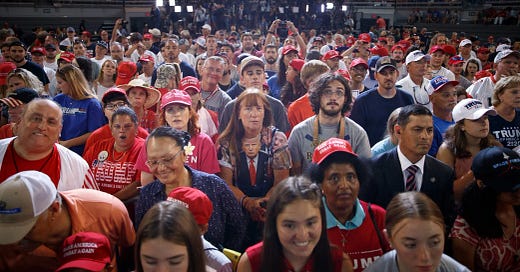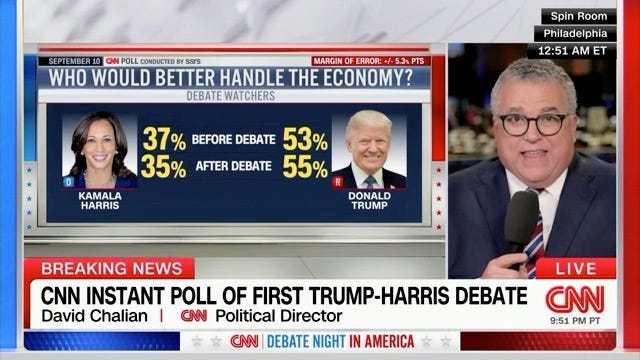Democrats are enjoying the afterglow of a successful debate by their candidate against Trump. Harris’s game plan of goading Trump into irrelevant and defensive tangents worked as intended. She was the “winner” of the debate to the extent these designations still have any meaning.
But the race is still exceedingly tight….and seems likely to remain so. And there’s another part of her game plan—or what should be her game plan—that does not appear to be working out so well.
I refer to the need to boost support among the working class, which remains a serious weak spot for the Democrats and Harris. The latest New York Times/Siena poll has Harris trailing Trump among working-class (noncollege) voters by 17 points. That’s identical to Biden’s working-class deficit in the last NYT poll before he dropped out and way worse than Biden’s deficit among these voters in 2020—a mere 4 points.
More detailed NYT results reveal that Harris, relative to Biden in 2020, is doing 10 points worse among white working-class voters and 18 points worse among nonwhite working-class voters. The latter is despite considerable improvement for Harris among this demographic since Biden dropped out.
There’s no sugarcoating it—this is a serious problem for the Democrats. College-educated America may be delighted with candidate Harris but working-class America clearly is not. And there are a lot more working-class than college-educated Americans. Remember that they will be the overwhelming majority of eligible voters (around two-thirds) and, even allowing for turnout patterns, only slightly less dominant among actual voters (around three-fifths). Moreover, in all seven key swing states—Arizona, Georgia, Michigan, Nevada, North Carolina, Pennsylvania, and Wisconsin—the working-class share of the electorate, both as eligible voters and as projected 2024 voters, will be higher than the national average.
The NYT data demonstrate how far apart the viewpoints of working-class and college-educated America are today. Consider the following class gaps in perception:
1. Biden’s net job approval (approval minus disapproval) is -34 among working-class voters but +8 among college-educated voters (class gap = 42 points).
2. Trump’s net favorability among working-class voters is +10; among college voters it’s -29 (class gap = 39 points). Harris’ favorability is -16 among the working class but +16 among the college-educated (class gap = 32 points).
3. While both working-class and college-educated voters have negative views about the state of the economy (only fair or poor), working-class voters are far more negative. Their net rating (excellent or good minus only fair or poor) is -67 compared to –35 among the college-educated (class gap = 32 points).
4. When asked which candidate could do a better job handling the issue they care about the most, working-class voters prefer Trump over Harris by 20 points while college voters prefer Harris over Trump by 15 points (class gap = 35 points).
5. The same question was asked about handling the economy specifically. Working-class voters think Trump would do a better job by 27 points; college-educated voters prefer Harris by 9 points (class gap = 36 points).
6. On handling immigration, working-class voters prefer Trump by 24 points while college voters prefer Harris by 11 points (class gap = 35 points).
7. And on democracy, working-class voters think Trump would do a better job handling the issue by 9 points, while college-educated voters overwhelmingly prefer Harris by 28 points (class gap = 37 points).
8. The poll asked separately for Trump and Harris whether they would be a safe or risky choice for the country. Working-class voters’ net assessment (safe minus risky) for Trump is +5 while for college grads it is -33 (class gap = 38 points). For Harris, her net safe/risky among the working class is -21 compared to +16 among college graduates (class gap = 37 points).
9. Finally, voters were asked whether the next president should represent a major change or minor change (or no change at all) from Biden. Almost all voters wanted at least some change but working-class voters were far more likely to want major change. Working-class voters’ net change preference (major minus minor change) was +46 but among college voters it was just +1 (class gap = 45 points).
These are rather daunting figures but of course they don’t mean Harris can’t win. Her performance among college-educated voters is very strong and that is keeping her afloat right now in this exceedingly tight right race. Perhaps her debate performance will improve her standing among working-class voters, which could pull her out of her current danger zone.
But there are clearly reasons for concern. Besides the data noted above, polling right after the debate found that Harris did little to improve voter confidence in her ability to handle the all-important issue of the economy. A CNN flash poll among debate-watchers found that before the debate voters trusted Trump over Harris on the economy by 16 points and after the debate they favored Trump by….20 points. Furthermore, if you look at the cross-tabs, working-class voters before the debate favored Trump over Harris to handle the economy by 29 points, an advantage for Trump which increased slightly to 32 points after the debate. Not exactly what the Harris campaign had in mind.
So, as the Harris campaign basks in a post-debate wave of favorable coverage and perhaps even a bump in the polls, they would do well to remember that working-class Americans can contain their enthusiasm. The Democratic Achilles’ heel remains and could still deliver a second term for Trump.







First, I will go on record for the umpteenth time. The race is not close. Trump underpolls an average of 2.1. So just factor that into ANY poll, and Trump is up nationally by 1-2, up in the EC at least to 312 EVs.
Second, Trafalgar did a post debate poll that captures precisely where we are: "Who won the debate?" Harris +13. "Who will you vote for?" Trump GAINED a point and added to his lead (+1.5 now). Regardless of what pundits said, poll after poll was 2:1 that Trump won the debate. EVERY focus group I saw said Trump won the debate, usually 2:1.
Third, I'm surprised, Ruy, that even you keep ignoring these planetary-sized changes in voter registration. Here's another: Yesterday NV REMOVED about 100,000 dead voters/bad address registrations from their rolls. Net change? Rs GAINED 23,000. When you factor in that Trump lost NV by 33,000, and that margin is now down to 19,000--and MANY of those culinary workers and working class Democrats that you correctly ID as a problem for the party, will vote Trump, NV now is moving into "safe" R. AZ is long past safe. The R edge in Maricopa Co. alone is 162,500 and Ds haven't added a net new voter in days. Rs add 200-300 daily.
Finally, there are leaks about both parties internal polls, which show (as you would suspect) Trump up nearly outside the margin of error or margin of fraud in every single swing state. So, for the umpteenth time, mark it down. This will not be a close election, Trump will win the popular vote, and the EC will end up 312-340 depending on how terrible Harris is going forward. But it's fine with me if reasonable insiders such as yourself keep misreading the tea leaves here, because there will be no time to adjust when it becomes clear what the early vote and voter registration #s mean.
Thank you for your efforts to provide balanced and objective information about this ultra tight election. My sense of it is that Democrats are voting for Harris because they trust the Democratic Party and because Trump terrifies them. The Republicans are voting for Trump because they favor his platform and reject most or all of what the Democratic Party has been advocating and doing for the past 4 years and previously. I don't believe it would have mattered at this point who the Dem Party chose to be the next president; the Dems would have voted for their candidate, and the Republicans would have voted against that person.
I am a left leaning independent voter, and I don't think I will ever again vote for a Democratic presidential nominee.